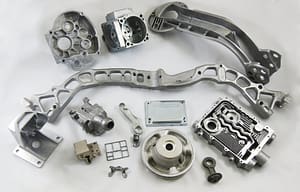Is it castable?
This question can save you and your organization a lot of money.
Metal casting processes have been around for a long time, but they are seldom foremost in the minds of companies as smart alternatives to machined or welded parts.

Why should they be? Mainly because they can save you a lot of money. Let’s say your part is currently being machined out of aluminum (a “hogout”) and is very expensive. It is expensive because it requires a number of machining steps in a CNC mill and perhaps it requires some wire EDM operations as well. It would not be surprising for such a part to cost $200 or more. But if you ask yourself “Is it castable?” you might find that casting will produce a part with most of the features you need already cast into the design (this is called “as-cast”) thus eliminating (or drastically reducing) the need for machining. I have seen parts that cost $200 as machined parts reduced to $20 as cast parts.
What about weldments? Same thing. Perhaps you have two or three parts being produced as machined parts (or even separate cast parts) and then being welded together into one weldment.
Is it castable?
If it is castable, you may be able to save a lot more money than you imagine. Some of the most exciting applications for casting are in these cases where multiple parts welded together are reduced to one cast part. Not only does it eliminate or reduce the machining, but it eliminates the welding, another cost savings.
Cost Factors
There are two cost factors to consider. The first is up-front tooling and the other is actual part cost.
What About Tooling?
Tooling is the upfront non-recurring engineering (NRE) that you pay for the die or mold required to cast your parts. This cost can be significant. How significant? That depends on which casting process is right for your part. The three processes I will compare are die casting, investment casting, and sand casting. There are other casting processes, but we will look at just these three. Each has its sweet spot from a design standpoint. Your part design and perhaps your volumes will determine which process is right for you.
Here are some tooling numbers for a small part we did a few years ago. This part was roughly the size of a softball, but not shaped that way. It had some fairly complex geometries that were costing a lot to do as a machined part. Here is how the tooling prices compared:
- Die Casting $26,000
- Investment Casting $10,000
- Sand Casting $6,000
You can expect a similar relationship of pricing for tooling for those three processes. Die casting is most expensive because of the complexity of the tool construction. Sand casting is least expensive. Investment casting is typically in the middle.
So, given the relative premium required for die cast tooling, why would you choose die casting? Perhaps your part has thin walls that cannot be achieved by a gravity process. Die castings are formed by injecting molten alloys into the die cavity under pressure. Sand casting is a gravity process, so the metal cannot be forced into small cavities under pressure to form walls as thin as are possible in die casting.
What About Part Cost?
The other piece of the puzzle is the piece part cost. What is the cost per part for each of these three processes? Using that same part and assuming an order size of 500 pieces, the costs break down as follows:
- Die Casting $8.00
- Investment Casting $22.00
- Sand Casting $12.00
On a piece part basis this relationship of part prices is a good rule of thumb. Die casting is usually the least expensive, investment casting is the most expensive, and sand casting is in the middle. However, I have seen situations where sand casting is competitive with die casting on a piece part basis at certain volumes. On other parts the volumes are so low as to make die casting inappropriate and to make investment casting the best alternative to machined parts. Again, many geometries will dictate one process over the other. Regardless of which process you choose, however, the part cost typically still represents a significant savings over the costs of the machined or welded version. The calculation of how long it would take to hit the break-even point on your tooling purchase is not hard to do.
So, Is it Castable?
The case can often be made that casting a machined part or weldment makes good financial sense, but can your part actually be cast, technically that is? This is where we work with you to help evaluate whether or not your part is suitable for casting. Not all parts are. The engineering groups at our casting foundries are experts in their casting processes. We work with you to evaluate your parts for suitability.
One of the mental leaps that must be made when thinking of converting a machined part or a weldment into a casting, is that casting is an additive process whereas machining is a subtractive process.
What does that mean? To create a machined part you begin with a machining stock like a block of magnesium or a cylinder of aluminum. That stock is then machined so that the alloy is removed (subtracted) where it is not needed leaving only the features and geometries required. A solid block is subtracted until the final part is created.
In casting we start with only an empty cavity in the shape of your part. The molten alloy is then added to that empty cavity to form it into the features and geometries of your part. Given the nature of the casting process you need to give consideration to things like draft, radii, and chamfers. Again, our engineers can assist with these issues.
There are other issues that impact this decision and which casting process may be ideal:
- Alloy Properties – There are important differences in properties between the alloys used for machining and those used for casting. A part machined from aluminum will not have the exact same properties as that same part cast in aluminum. Therefore, careful attention must be given to an analysis of the various alloys for your application. Engineers that are making this evaluation will usually compare the critical properties of the casting alloy and will often run Finite Element Analysis (FEA) to model the performance of the part with the target casting alloys. You can find helpful guides to casting alloys at the links listed in “Next Steps” below. Also, the target alloy may well determine which casting process is appropriate. Stainless steel, for example, is not a candidate for die casting because of its high melt point, but is a fit for investment casting.
- Tolerances – Not only will minimum wall thickness determine which casting process is appropriate, but each of the various casting techniques have different tolerances. Your tolerance requirements will often drive your process selection. Let’s take aluminum and compare the three processes we have discussed above. Here are some examples of tolerances:
- Die Casting – Aluminum: ± .002” per inch
- Investment Casting – Aluminum: ± .003”/in to 1/4″ per inch
- Sand Casting – Aluminum: ± 1/32” up to 6″. Add additional .003″ per inch
- Secondary Operations – Will your part contain all of the features it needs as-cast or will it require secondary machining operations? Machining is relatively expensive, so sometimes one casting process may have an overall lower cost than a competitive process if it requires less machining. This is the reason that the quotes you get should contain not only the as-cast or raw casting cost but also the required machining. This will allow you to truly compare the lowest cost option for your application.
- Finishing – Some people are surprised to learn that parts with a certain finish in a machined part will not have the same cosmetic result in a cast part. For example. machined aluminum parts look great when anodized, but a cast aluminum version of that same part will not look so good when anodized. Your casting foundry will have expertise in what your finishing options are and what will look good for your part in a casting, but this is just another factor to consider. Among the many options for finishing castings are powder coating and wet paint.
Conclusion
Converting a machined part or weldment into a casting can obviously be profitable. Every dollar you save on the cost of your parts is a dollar that flows to the bottom line. Not only is converting parts to casting profitable, the process of evaluation and conversion from a design standpoint is a fun and creative process. Some may say I have a low bar for “fun,” but I stand by that claim. The clients I work with invariably have fun in the process and usually come out smelling like a rose at their companies for saving money that helps the organization in a tangible way. So, conversion for fun and profit.
Next Steps?
You owe it to yourself to visit Chicago White Metal’s Design Center. There you will find a treasure trove of technical documents, white papers, and webinars on many aspects of die casting. For example, there is an excellent webinar available titled “Machining to Die Casting: A Guide to Conversion.”
CWM’s website also has a great section with Case Studies of die castings.
Also, you can check our Baselodge Tech Room for two guides to sand casting alloys and casting design from Precision Enterprises Inc.
To discuss your application, please Contact Us. We cover Texas and bordering states, but even if you are outside our territory, we will be happy to point you in the right direction.
